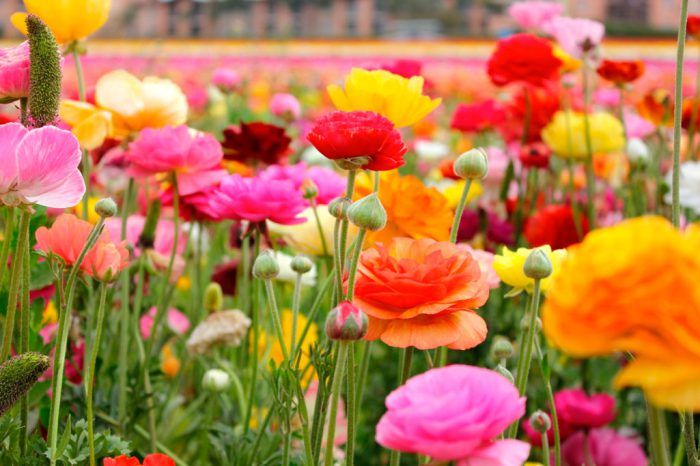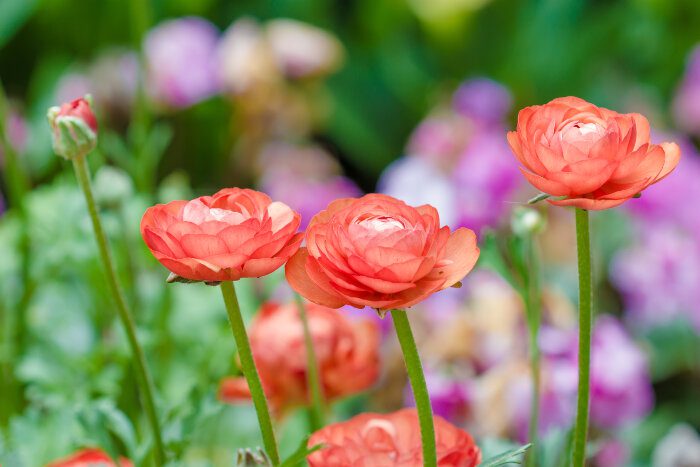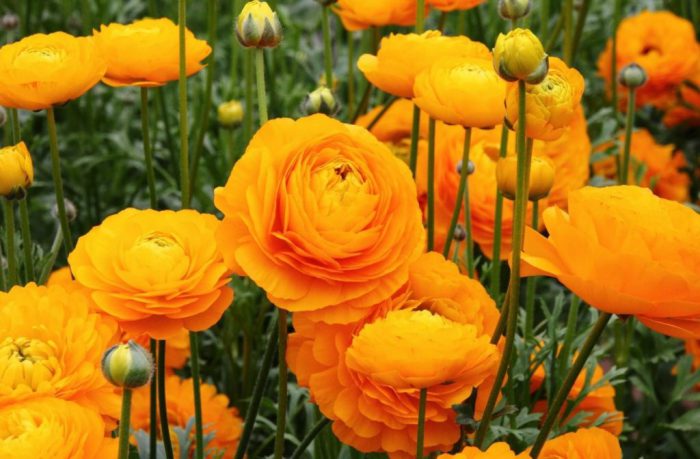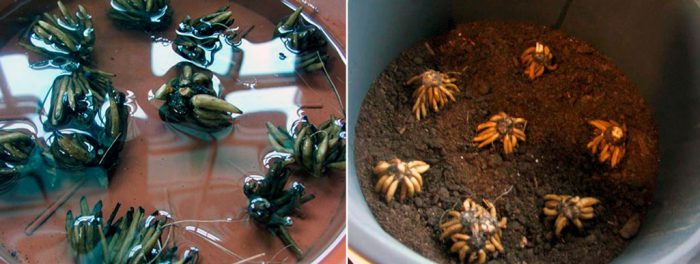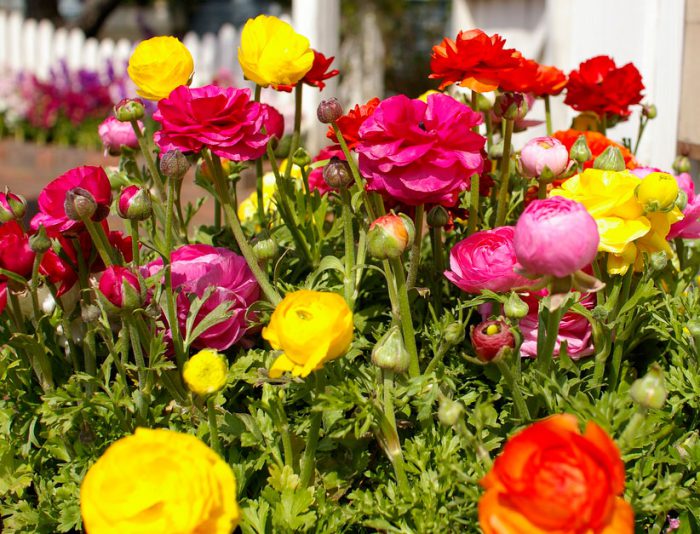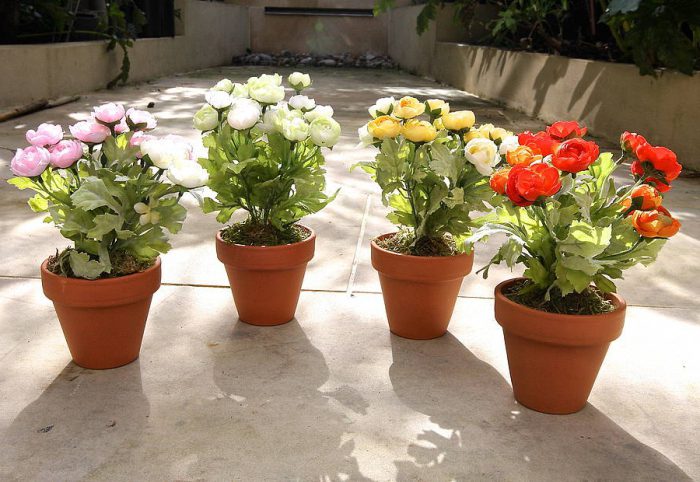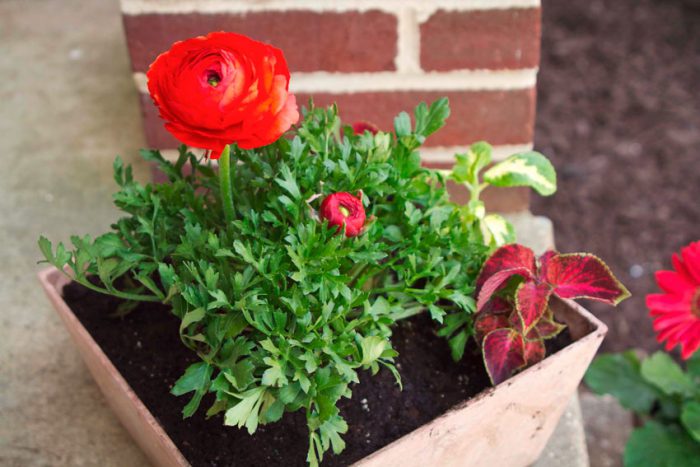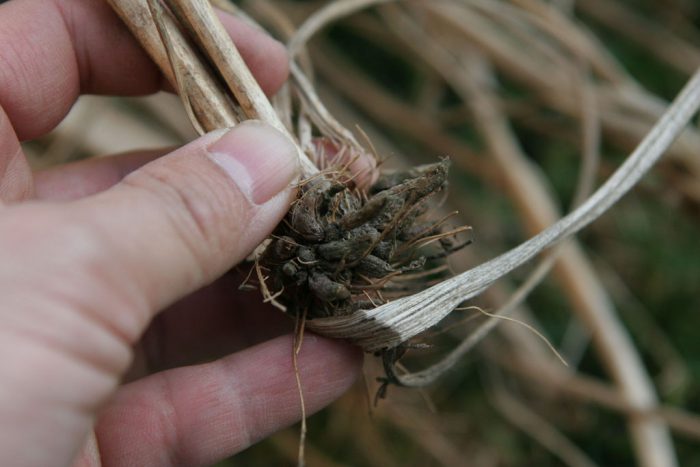Ranunculus (Ranunculus) is also called the garden buttercup (Asian). The birthplace of such a plant belonging to the buttercup family is Asia Minor. The names of these flowers were given by the scientist Pliny, who lived in ancient times. From Latin ranunculus translates as "frog", the fact is that most species of such flowers prefer to grow in swampy places. In the 16th century, this plant was brought from Turkey to England and gained great popularity among flower growers there. However, since the end of the 19th century, it has lost its former popularity, but now these flowers are in increasing demand every year. At the moment, this genus unites more than 600 different species of ranunculus. If you cut a flower of such a plant and place it in a vase, then it will retain its freshness throughout the crescent. Italians call the garden buttercup "golden meadow buttons". There is a famous legend that Jesus turned small stars into buttercups and presented them to his mother as a sign of love and respect ...
Content
Features of ranunculus
The Asian ranunculus is a pretty showy flower. It is used to decorate apartments and gardens, growing on balconies, terraces and living quarters. The height of the bushes can vary from 20 to 80 centimeters. Deeply dissected leaf plates are located on strong shoots. The rhizomes are presented in the form of tubers, shaped like the legs of geese. The shoots of this flower, along with the roots and leaves, are very similar to the dahlia. Very showy flowers can be semi-double, double and densely double. They differ in a variety of colors, but blue and blue flowers are not found. Their diameter varies from 5 to 10 centimeters, and they bloom gradually from May to August. At the very beginning of their opening, the flowers are similar to roses. And after full disclosure, they are very similar to terry poppies. Very often, pink ranunculus and white ranunculus are used when drawing up a bride's bouquet. But do not forget that the juice of such a plant is poisonous.
Gardeners and florists are engaged in the cultivation of various species and varieties of Asian ranunculus.He, in turn, originally had 2 varieties, namely: turban or African ranunculus (Ranunculus africanus), the flowers of which are similar to peonies, and Persian ranunculus (Ranunculus Persian), its inflorescences have a certain resemblance to a rose.
Growing features
In order to grow beautiful flowers, you must adhere to certain rules in caring for them:
- While fertilizing the soil, you can burn the roots of the plant. In this regard, you need to opt for those fertilizers where there is vermicompost.
- The flower reacts extremely painfully to transplants, in this regard, it should be disturbed only if absolutely necessary.
- When a buttercup blooms, it needs limestone and potassium.
- To increase the duration of flowering, experienced growers advise to reduce watering and move the flower pot to a dark place.
- When the leaf plates are completely dry, the plant's tubers must be dug up and stored for the winter, because the ranunculus is not frost-resistant.
- If you want to have a spectacular bouquet at home, then in one container you can plant several copies of such a plant at once, which will differ in the color of the flowers.
- Inflorescences that have begun to fade should be removed, in this case, new flowers will open faster. At the end of the summer period, the shoots must be cut to the ground.
How to plant in open ground
How to prepare the ground
Buttercup (garden ranunculus) can grow and thrive quite well in a sunny location, but shade works best for it. The fact is that there such a flower retains a more saturated color of inflorescences, while the duration of flowering increases markedly. Also, the buttercup should be protected from the influence of drafts. Such a plant does not tolerate sub-zero temperatures; therefore, it should be planted only after the threat of frost has passed.
The soil for ranunculus is most suitable for light, neutral acidity and rich in nutrients. So, it can be peat or humus mixed with black soil. But it is imperative to add chalk to it to neutralize. On a site with loam, such a flower cannot be planted. Remember that the soil should perfectly absorb water during irrigation, but it should not linger in it for a long time. Plants need good drainage to avoid rot formation. To do this, add, for example, a small amount of sand to the bottom of the planting pit. Before planting a buttercup, you need to dig up the soil, while adding compost to it. And also to cultivate the soil with a foundation.
What time is the sowing of seeds
Growing buttercup from seeds is a rather difficult process, and all because they have a relatively low percentage of germination. Experienced gardeners advise to collect seeds only from those flowers that have faded first. In order for the seeds not to spill out onto the surface of the soil, the inflorescences must be wrapped with gauze. Sowing should be done in mid-February. For this, a light substrate enriched with useful substances is used. After the seeds are sown, sprinkle them with a very thick (1.5 to 2 centimeters) layer of soil. On top of the container, you need to put transparent glass or stretch the film. The container should be moved to a place with good lighting, where the temperature is within 15-17 degrees. If necessary, it is necessary to moisten the soil. The first seedlings should appear 14–20 days after sowing. When this happens, you should remove the cover from the container. When 2 pairs of true leaves grow, the ranunculus will have to dive into individual pots. When the threat of frost passes in the spring, these flowers should be transplanted into the garden.Flowering will be observed only next year, so if you want to get a quick result, this method of reproduction of ranunculus is not suitable for you.
What time is the planting of tubers
After the soil warms up and the frosts are left behind, you will need to plant buttercup tubers in open ground. As a rule, this time falls on the last days of April, the first - in May. Planting tubers is not difficult, but there are rules and tricks that should not be forgotten. Before planting tubers, they must be prepared. To do this, they are laid out in well-moistened moss, sawdust or on a moistened sponge. The tubers should sit for several hours. The same effect can be achieved by soaking in cold water or in a weak solution of potassium manganese. In some cases, it is recommended to add a growth-promoting substance to the liquid. Choose the most suitable place for such a flower at once, since it is not recommended to transplant it.
It is necessary to lower the tuber into the prepared planting hole with the "beak" down to a depth of 5 to 8 centimeters. It is necessary to maintain a distance of 10 to 15 centimeters between plants. In the event that frosts are expected, then the plantings should be covered with straw or special covering material. After 2-3 months, several peduncles will grow on each bush, and flowering will begin after some time.


Watch this video on YouTube
Features of care in open soil
It is quite easy to care for such a plant. It is necessary to moderately systematically water the ranunculus, but at the same time make sure that the soil does not become waterlogged, as in this case rot may form. You can find out that the flower has begun to rot by the mold on the leaf plates and by the dropping of the buds. The affected parts of the flower should be cut off, the soil around it must be loosened and watering must be reduced. Timely need to remove faded flowers, as they will prevent the flowering of other inflorescences. This plant needs regular loosening of the soil, and it must also be fed using organic fertilizers. So, 2 times a month, potash fertilizer must be applied to the soil (per 1 square meter from 40 to 50 grams of the substance), and during flowering, potassium sulfate, potassium salt or wood ash are suitable for this. A spider mite can settle on a buttercup bush (especially during a summer drought). Thrips and aphids can settle on leaves and shoots. When you see whitish or silvery spots on the foliage, immediately take measures to destroy the pests. For this, the bushes must be treated with suitable insecticidal agents. For preventive purposes, ranunculus should be treated with a solution of mercaptophos (0.2%) 2 or 3 times a week.
How to care at home
How to plant indoors
Taking care of buttercups growing on the balcony is also not difficult, as well as those that are grown in the garden. However, in order for the plant to grow and develop well, you should remember some rules and secrets. In indoor conditions, such a flower should not be grown as a single, therefore, it is recommended to plant several bushes in one pot at once. For planting, you can use both a decorative box and a fairly voluminous pot purchased at a store, in which there must be holes for drainage on the bottom. For planting, you need exactly the same soil as in the garden, or rather, peat-based soil. The tubers should be immersed in water for 24 hours before planting. A good drainage layer should be laid on the bottom of the pot or box; expanded clay, crushed stone or egg shells are suitable for this. Then the earth is poured and nodules are laid out on its surface.They must be covered with soil in such a way that only the tops rise above the surface. With a sufficient volume of a flower pot, several nodules can be planted in it at once. Water well and remove for the first time in a cool enough place (about 12 degrees). Soil moistening should be carried out as necessary.
How to care
When the sprouts reach a few centimeters, the pot should be moved to a warmer place (from 20 to 22 degrees). If you walk, enjoy the beautiful flowers of ranunculus as long as possible, then during the flowering period it should be provided with a temperature of about 18 degrees (not lower, not higher). Such a plant, grown indoors, needs direct sunlight. In this regard, it is recommended to place it on the windows of western or eastern orientation. However, a southern window works best for a buttercup. When it is warm outside, then these flowers, if desired, can be placed in fresh air (balcony, terrace). They need systematic watering, while during intensive growth it is recommended to add fertilizers to the water. Watering is top, however, try to avoid waterlogging of the soil. From time to time, you need to moisten the foliage with a sprayer. When the plant begins to wilt, you need to water it much less.
Ranunculus after flowering
How to dig up and store tubers of garden ranunculus
The tubers are excavated in the autumn. After the shoots and leaves turn yellow and dry, they are cut off, and tubers are dug out of the soil. It should be remembered that the rhizomes of such a plant are quite delicate and can easily break, so they should be dug out carefully. Such a perennial can die at temperatures less than minus 7 degrees; therefore, it is recommended to store the dug tubers in a well-ventilated basement, where the temperature should be between 4 and 6 degrees. In this case, the tubers need to be wrapped with dry moss or put in a paper bag. Before removing the nodules for storage, they are processed in the foundation for half an hour, and after that they are allowed to dry well in a shaded place for about 3 days. Such a perennial plant in places with mild winters does not need to be dug out, they are simply covered with fallen leaves or spruce branches.
Caring for indoor ranunculus after flowering
After the ranunculus has faded, it must be removed to a shaded and cool enough place. The flower will grow for some time, and then it will have a dormant period, while the shoots and foliage will turn yellow and dry out. Transplant the flower into fresh substrate and transfer it to a place with a temperature of 15 to 18 degrees. The duration of the dormant period is about 4 weeks, young sprouts will appear already in April. During the period of intensive growth, each nodule has 5 to 7 young shoots. They are dug up and carefully separated. Then the tubers can be planted in individual pots or they can be stored until spring on a refrigerator shelf in the vegetable section or in the basement. It must be remembered that from such "preserved" nodules weaker plants grow and their flower diameter is comparatively smaller. Most inexperienced growers therefore acquire fresh nodules every year.

